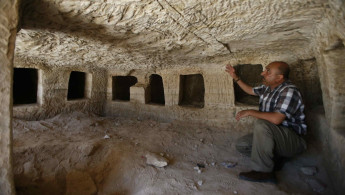Roman-era tombs discovered in Palestinian village near Hebron
A set of Roman-era tombs dating back some 2,000 years have been discovered near the Palestinian city of Hebron in the occupied West Bank during road works, an official said on Thursday.
The cemetery dating to the first century AD, when the region was under Roman rule, was found in the village of Idna in the southern West Bank around two weeks ago.
It was discovered during road works in mountainous terrain in the area, said Taleb Jubran, director of the department of tourism and antiquities in Hebron.
Bones, pottery and some 32 tombs set into stone were found. It was clear to archaeologists that artifacts had been stolen from the site before it was officially discovered, said Jubran.
"This discovery is very important for us to study it and to preserve it," Jubran said.
Read more: Archaeologists in Egypt uncover Alexandria's largest ever Sarcophagus find
The tombs were set out over a space of some 50 metres.
Officials also hoped to turn the site into a tourist attraction, while further study of it would continue to turn up details of what was found and its importance, he said.
 |
| Taleb Jubran with pieces of bones and pottery found in the tombs [Getty] |
A large number of remains from the Roman era can be found and visited in the Palestinian territories as well as the Levant region as a whole.
In January, flash-flooding in the Gaza Strip led to the discovery of another Roman-era tomb complex, some still with piles of bones in them.
Gaza-based archaeologist Ayman Hassouna said the finds suggested the grave dated back to the Roman era, approximately 2,000 years ago.
"The burial and excavation methods in this tomb date it back to the Roman period but it may have continued in use into the early Byzantine period (5th to 7th centuries AD)," he said.
Gaza was a prosperous port in the Roman and early Byzantine periods and boasted many ancient monuments that have since been lost.
Follow us on Twitter: @The_NewArab



